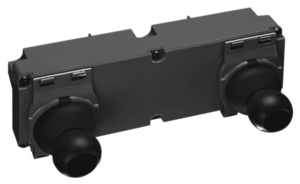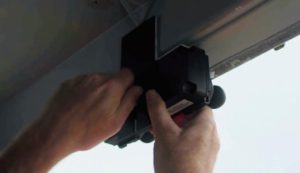
[From the last episode: We saw the role that blockchainAn electronic ledger system where all entries are confirmed by some decentralized mechanism, like voting, and cryptographically attested so that, if someone changes one entry anywhere, it will be obvious. technology can play in IoTThe Internet of Things. A broad term covering many different applications where "things" are interconnected through the internet. securityRefers to whether or not IoT devices or data are protected from unauthorized viewers..]
Today we take a break from security stuff to look at yet another industrial application of IoT technology. This one deals with shipping containers. It comes courtesy of two companies: Eye-Seal, which has built tracking technology, and Telit, Eye-Seal’s cellular communications partner.
The Problem with Containers
Companies that ship goods have a problem. The shipper puts the goods into a container; that container travels across an ocean; and when the container arrives at its final location, some of the material is missing. Insurance companies cover losses, but not all claims are valid. If someone says that something was missing, but there was no evidence of a “breach” of the container seal, then it’s considered fraud.
But there’s more. A container leaves it’s starting point on a truck, gets transferred to a ship (perhaps after riding the rails in between), and, on the other end, it gets unloaded, then travels by truck and/or rail to its final destination. According to the companies, there can be as many as 12 parties involved, each with its own insurance company. So, if something goes missing, which insurance pays? That depends on where the breach occurred (assuming a breach actually did occur).
Some things being shipped can be tagged, but other items – like coffee, cocoa, and cans being recycled – can’t be tagged. Someone might open the container and siphon off, oh, 10 or 20% of the contents. Not enough to make it immediately obvious that something’s missing. How do you know when and where that happened?
Here we enter the world of insurance forensics: digging up proof as to what happened and who’s responsible. How do you figure that out?
That’s what Eye-Seal has helped with, in partnership with Telit. They have a device that mounts inside the container; it can tell whether someone has opened either of the doors. It can also record when (which shows where) it happened.

(Image courtesy Eye-Seal)
How It Works
It does this with two sets of sensorsA device that can measure something about its environment. Examples are movement, light, color, moisture, pressure, and many more.:
- Two proximity sensors to detect when the door opens. The container has one opening with two doors; the unit is placed inside, above the middle of the door, and each side of the unit has an IR proximity detector that can report when either side opens. They’ve tuned the sensor so that it can allow normal subtle motion (on a truck, bobbing on the sea, etc.), meaning they measure only the door opening.
- A light sensor to measure a change in light inside the container. This is another indication of an open door.
- There’s also an environmental sensor tracking humidity and temperature. These aren’t related to breach detection, but they help with contents that can spoil if the temperature and humidity move outside a specific range. It’s just kind of an extra thing that can help alert someone that the contents may have gone bad (or may have had their lifetimes shortened).
The devices contact Eye-Seal’s cloud facility using cellular technology. They can check in regularly or they can check in when something has happened. Telit can operate in 190 countries, giving broad coverage with a single device.
What about on the ocean? No cell towers out there! But the device checks in before it goes out of range, stores all its records while out of range, and then checks back in and uploads the stored data when it comes back into range at the other end of the trip. If it never checks back in, then it was probably (or presumably) lost at sea.
Shouting Out from Inside
One of the big tricks they pulled off is making this thing completely internal to the container. Why is that so hard? Because they’re trying to send a signal out from within a metal cage. Usually that involves some kind of antenna on the outside of the box – which can come off by accident or on purpose. All the normal rules of physics say that the metal container should block any signals from going into or out of the box. How do they do it? They’re not saying…
Each device is good for one trip. The service is pre-paid and good for 120 days. At the other end, the shipper can trash or recycle the unit. Some of their customers refurbish and reuse them.
There is a cost, of course; they say that the cost for this is about half the cost of competing solutions. Their hope is that it will save on insurance: ideally, if the insurance companies feel like they’re less at risk of fraudulent claims or paying for a claim that someone else should have paid for, they should be able to ease their premiums.

(Image courtesy Eye-Seal)
[Editor’s note: updated to remove a price. The price was discussed, but apparently it was an internal number and not representative of actual pricing, so I’ve removed it at Eye-Seal’s request and, instead, made a general cost comparison to alternative solutions.]
[Editor’s note: the piece was further updated due to some sensor confusion. In my conversation, I interpreted the door-opening detector as a motion sensor, or IMU. Turns out that, in their world, IMU means “internal mounting unit,” not “inertial measurement unitA sensor that uses inertia to measure acceleration or deceleration either in a straight line or in rotation..” So we were agreeing on different things. In fact, proximity sensors, not IMUs, are used. So there’s one per container, not one per door.

Leave a Reply